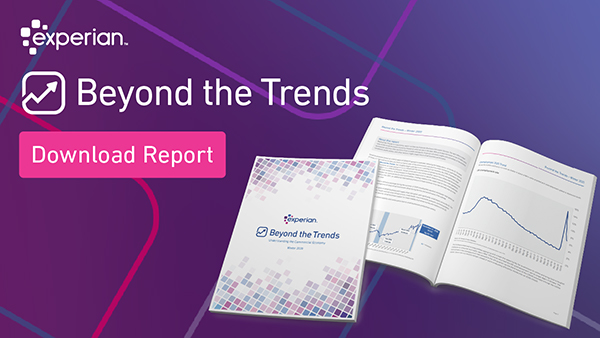All posts by Brodie Oldham

This handy guide explains the practice of Credit Portfolio Management, managing, and monitoring all aspects of your company's credit portfolio.

Experian has released the Summer 2022 Beyond the Trends report, our deep dive on the small business economy based on our commercial small business insights.

We've all been experiencing higher prices for food, housing, and certainly at the gasoline pump. If these economic headwinds have raised concerns about how small businesses are being impacted, we have some fresh perspectives in the Spring 2022 Beyond the Trends report. Beyond The Trends offers a unique view of the small business economy based on what we see in the data. With up to date information on over 25 million active businesses and how they perform from a credit standpoint. Here’s my quick take on what’s in our latest Beyond The Trends Report The next 12 months will be filled with headwinds and mines for small businesses. These entities have been shoring up resources, operations, building in cost increases, and creating backup supplier networks as supply chain disruption and inflation will batter the ship through 2023. Highlights: Consumers seek higher paying jobs, creating labor shortages in blue collar industries, as wage gains are being eaten away by increasing U.S. inflation. Transportation and the utility industries have seen a 69% increase in delinquent balances tied closely to the increase in U.S. inflation. A 4X increase in delinquent balances associated with mining as the US took steps to move away from fossil fuel. Commercial card lending grew 9.9% in the 4th quarter, even as delinquency rates began their upward climb. Energy Takes Center Stage Energy costs are hitting margins and impacting delivery of goods and services. US energy costs were up 27% in January according to the Bureau of Labor and Statistics. These costs have been rising sharply since March 2021 and will be exacerbated in the 1st quarter 2022 by global reaction to the Russian incursion in Ukraine. Energy supply chains will be disrupted by sanctions and higher transport costs. !function(e,i,n,s){var t="InfogramEmbeds",d=e.getElementsByTagName("script")[0];if(window[t]&&window[t].initialized)window[t].process&&window[t].process();else if(!e.getElementById(n)){var o=e.createElement("script");o.async=1,o.id=n,o.src="https://e.infogram.com/js/dist/embed-loader-min.js",d.parentNode.insertBefore(o,d)}}(document,0,"infogram-async"); Inflation Looms Consumers and small businesses will feel the pinch of lower supply and higher costs. Inflation, outside this event and on the rise, will remain above the Federal Reserve target of 2% through the end of 2022, even as the Fed raises rates and begins to reduce their balance sheet. The US supply chain will be in a slow recovery mode as infrastructure stimulus and global markets return to capacity. Small businesses are adjusting to a high demand low supply market through 2023. !function(e,i,n,s){var t="InfogramEmbeds",d=e.getElementsByTagName("script")[0];if(window[t]&&window[t].initialized)window[t].process&&window[t].process();else if(!e.getElementById(n)){var o=e.createElement("script");o.async=1,o.id=n,o.src="https://e.infogram.com/js/dist/embed-loader-min.js",d.parentNode.insertBefore(o,d)}}(document,0,"infogram-async"); Download Spring Beyond The Trends Report

This perception of the marketplace has been a concern of consumers and small business owners, in the US, as they manage through the pandemic hampered marketplace. Small businesses are adjusting to a high demand/ low supply market that is expected to continue through 2022. The ability to move raw materials to manufacturers, products across borders, find space in warehouses, and put products on the shelf has become challenging as pandemic variants add pressure to a slowly recovering supply infrastructure. Large market participants will find disproportionate advantage, over small business competitors, widens as distributors focus on their largest clients and small clients feel cost and availability squeeze. Consumers store front engagement will increase, with a tangible delivery advantage, as distrust grows in a digital only storefronts ability to deliver on time. Here's my quick take on what's in our latest Beyond The Trends Report The Experian Winter 2021 Beyond the Trend report looks at consumer willingness and ability to spend behavior tied to the bets commercial supply chain industry participants are making, to ensure demand is met, emerging from the heart of the pandemic: Originations for new businesses, with less than a year in business and already participating in the commercial credit market, are up 157% from pre-pandemic levels. 36% of active U.S. businesses have been operating less than 1 year, as the spike in new business applications continue to be elevated. Commercial lending up 95% from same time last year to supply chain participants (Manufacturing, wholesale, retail, transportation, and warehouse) Although delinquency rates are historically low rates for wholesalers (Up 600%) and retailers (Up 101%) have been on the rise a components and inventories are slow to arrive. To operate at full capacity, small businesses will need consumers willing to spend. The fed will begin to taper and raise rates much earlier than expected, March 2022, to add downward pressure to inflation. Small businesses are betting on growth as investors view variants as a bump in the road vs a blocker. New business applications continued to roll at ~400k a month in 2021. This untapped market expansion will drive traditional lenders to reassess the risk of engaging emerging businesses in their first year of operation with limited historical commercial performance. !function(e,i,n,s){var t="InfogramEmbeds",d=e.getElementsByTagName("script")[0];if(window[t]&&window[t].initialized)window[t].process&&window[t].process();else if(!e.getElementById(n)){var o=e.createElement("script");o.async=1,o.id=n,o.src="https://e.infogram.com/js/dist/embed-loader-min.js",d.parentNode.insertBefore(o,d)}}(document,0,"infogram-async"); Supply chain bottlenecks will slowly dissipate. We expect to see variability in product availability as goods are delivered which will create scenarios of over-supply of some products while others remain tied up in transit. Lenders and creditors should monitor commercial health of businesses they interact with directly and indirectly to ensure portfolio stability and accurate risk based pricing. 2022 will be a recovery year for the US market. Consumers keep shopping! Small businesses keep fighting! The shelves will be full soon. Download Winter 21/22 Report

The Beyond The Trends Report - Fall 2021 Out Now! Did you know that there are about a million restaurants in the U.S? And those restaurants employ nine million people? As we prepared the latest Beyond the Trends report for Fall 2021, I took a deep dive into the restaurant industry in our small business data set to explore how restaurants were performing through the pandemic and how resilient they are now. Here's a quick snippet — the SBA's Restaurant Revitalization fund delivered 74,498 grants accounting for $22.4B in funds for May through June of 2021. It's a shot in the arm for restaurants. Here's how the funds were distributed based on annual sales. Distribution of Restaurants by Annual Sales Size source: SBA, Experian The RRF program has done well servicing a diverse set of applicants and underserved community segments. The Women-owned businesses made up almost half of the recipients Veteran-owned businesses were only 5% of the program. Veterans received fewer loans overall but had much higher average loan amounts awarded Restaurants in LMI designated areas were over a quarter of the program Restaurants in lower socioeconomic areas were over a third of the program's recipients Would you like to learn about this and other trends impacting small business? Download the Fall 2021 Beyond The Trends Report! Download the Latest Report

In this post, I would like to share some thoughts on the emerging business threat from the Delta Variant as it pertains to small business credit performance. Small Businesses are emerging New business applications are up 53% in the past 12 months, consistently coming in around 450k applications a month. We see these businesses become visible to commercial credit markets 3-4 months following the application. Industries including retail, transportation & warehousing, and accommodations & food services top the list as some of the fastest-growing sectors, particularly in the southern United States. Growth most pronounced in South, with FL, GA, NC Leading (5-year trend) Lenders and creditors are working hard to meet the need of their current customers and rapidly expanding inclusion programs to engage the underbanked in communities and provide access to new businesses. These emerging businesses and micro-businesses will not have the traditional credit history to access private commercial funding without the inclusion of non-traditional data. As stimulus support and moratoriums wind down, the concern is the resilience of small businesses as COVID spread and regional public policy decisions apply pressure to commercial growth and consumer spending. COVID-19 Delta variant emerges as a likely business spoiler The more contagious COVID19 variant is spreading quickly across the U.S., increasing to 21 times the average daily new case count in the last 30 days. Public policy limitation to commerce From a foot traffic perspective, the Delta variant surge has not greatly impacted small businesses as policymakers struggle to hold off on resuming state and local COVID commerce restricting policies. As case numbers rise, legal challenges to this restraint will waiver. We are seeing the return of mask mandates and capacity limitations amid indecision about whether or not schools can or will open in the fall or if remote classrooms will continue. These policy reversals and additional restrictions will be focused on social distancing versus lockdown strategies. This means stores will stay open to foot traffic, but consumers will become warier of utilizing this in-person experience. Delta hotspots highlight the small business threat A slow-down in foot traffic will place pressure on small business growth. Consumer confidence and re-emerging health concerns will play a role in how consumer spending impacts Main Street in the lead-up to the holidays. Regional COVID spread hot spots will impact supply chain for specific industries. As the variant picks up pace the travel industry and supporting industries (Hotels, Restaurants, etc..) will see customers warier to utilize the service, putting a damper on growth in this sector. COVID-19 has impacted all regions of the U.S. We needed a reset to understand how the newest variant is impacting areas outside of previous surges. Experian created a Delta Variant index to understand how small businesses will be affected differently now vs prior surges. We see a divergence of regional growth trends impacted by variant spread, macro-economic pressures, labor re-engagement, and consumer spend. Global trade pressures will continue to impact supply chain success. Creditors are formulating new risk management strategies for onboarding, term flexibility, balance management, and treatment that include traditional and non-traditional data. This COVID variant RESET, how we evaluate small business impact due to spread, is important in identifying areas of resilience and accelerated growth opportunity and uncovering industry and local risk. View COVID Risk Dashboard The COVID-19 U.S. Business Risk Index was developed by Experian Business Information Services to help businesses better understand the impact COVID-19 may have on their commercial operations. Related posts 4 ideas to help your company weather the COVID-19 downturn Visualizing the business impact of COVID-19 with Business Risk Simulator Tool

Summer 2021 Beyond the Trends report. This report goes into a deep dive into the economic trends that we're seeing in the market. We look at some commercial and consumer credit trends that will impact recovery. And we'll deep dive into some of the industries that are most impacted. One of the things we talk about in this edition is the important role small businesses play in the economy. With vaccination rates rising, consumers are starting to return to Main Street, dining at restaurants, going to movies, and traveling. But supply-chain shortages are driving prices up, and with it, the worry over inflation. Stay informed by downloading your copy of the Beyond the Trends report. Download Beyond The Trends Report

Beyond the Trends Spring 2021 - now available We're excited to announce the release of our second Beyond the Trends report. This report's going to deep dive into the economic trends that we're seeing in the market now. We look at some commercial and consumer credit trends that will impact recovery. And we'll deep dive into some of the industries that are most impacted. One of the things we talk about in this edition is economic growth. As excitement builds within the markets and reopening continues across different regions, we see an expectation for 7% GDP growth in the U.S. We're seeing a 27% increase in business starts year-over-year, and businesses reopened. We have new businesses emerging as well. In this report, we'll look at ways that lenders, as well as businesses, will be seen in credit markets and how growth can occur. Finally, with new stimulus in the market, consumers are ready to spend. Small businesses will look for opportunities to move from security mode and safety mode, business preservation into a transformational growth mode. Stay informed by downloading your copy of the Beyond the Trends report. Download the latest report

New Experian Report: Beyond the Trends Experian Business Information Services is excited to present our new quarterly report "Beyond the Trends." In this report, we'll be evaluating challenges to particular industries. We'll be looking at account management, pre-treatment, and treatment strategies for small businesses coming out of COVID. The Winter edition has just been released, download your copy below. . Download Report
